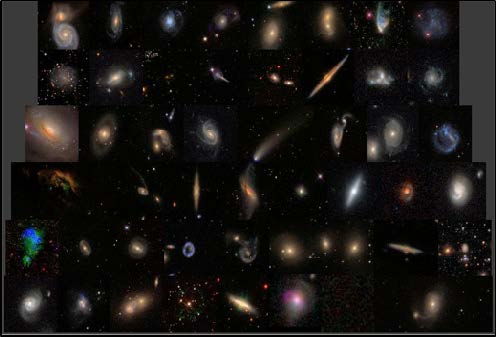Maunakea, Hawaii – One of the most scientifically productive adaptive optics (AO) systems on Earth is getting a major upgrade, one that will further advance high-impact research on the hunt for habitable exoplanets, the supermassive black hole at the center of the Milky Way, and the nature of Dark Matter and Dark Energy.
The National Science Foundation (NSF) has awarded funding to the W. M. Keck Observatory on Maunakea, Hawaii for a significant enhancement of the performance of the AO system on the Keck II telescope.
“The Keck telescopes were the first large telescopes to be equipped with adaptive optics and subsequently laser guide stars. All major astronomical telescopes now have laser guide star AO systems. Despite this competition, Keck Observatory’s AO systems have remained the most scientifically productive in the world. This upgrade will help maintain our science community’s competitive advantage,” said Principal Investigator Peter Wizinowich, chief of technical development at Keck Observatory.
AO is a technique used to remove the distortions caused by turbulence in the Earth’s atmosphere. This results in sharper, more detailed astronomical images. This upgrade will further improve the clarity of the images formed by the telescope.
The project will deliver a faster, more flexible real-time controller (RTC), as well as a better, lower noise camera for wavefront sensing. This will reduce the camera readout and computation time between the time that an image is captured and a correction for atmospheric blurring is made.
“Any delay means the correction is applied for atmospheric turbulence that has already started to change. Even if the correction happens in just a few milliseconds, we want to reduce the delay to a minimum. The new RTC computer and camera uses advanced technology to do just that,” said Sylvain Cetre, a software engineer at Keck Observatory who plays a lead role in developing the new RTC.
Recognizing this as a valuable STEM (Science, Technology, Engineering, and Mathematics) opportunity for education and workforce development, Keck Observatory will include a postdoc as well as a Hawaii college student from the summer Akamai Internship Program to work on the development of the project.
“Part of Keck Observatory’s mission is to train and prepare future generations so the work continues long after we are gone,” said Jason Chin, a senior engineer at Keck Observatory and project manager for the new RTC. “Many of Hawaii’s finest students, scientists, and engineers end up working on the mainland away from their families. We want to show them there is a vibrant tech industry in Hawaii. One of the ways we do that is by participating in the Akamai Internship Program, which has one of the highest retention rates for Hawaii college students staying in the STEM field. We are proud that many are working in our local tech industry.”
Co-Principal Investigators Andrea Ghez, Director of the UCLA Galactic Center Group, Jessica Lu, Assistant Astronomy Professor at UC Berkeley, Dimitri Mawet, Associate Astronomy Professor at Caltech, and Tommaso Treu, Physics and Astronomy Professor at UCLA, will also involve graduate and postdoc students. Their teams will use the new capabilities of Keck Observatory’s AO system to pursue science projects in three fields of study:
- Characterizing planets around low mass stars via direct imaging and spectroscopy
- Testing Einstein’s Theory of General Relativity and understanding supermassive black hole interactions at the Galactic Center
- Constraining Dark Matter, the Hubble constant, and Dark Energy via strong gravitational lensing
“These instrumentation improvements will not only enhance the scientific return of our existing AO system, but it will also provide an excellent platform for future improvements,” said Wizinowich. “We were very pleased to learn that our proposal was successful.”
The upgrade is expected to be completed by the end of 2020.
ABOUT ADAPTIVE OPTICS
W. M. Keck Observatory is a distinguished leader in the field of adaptive optics (AO), a breakthrough technology that removes the distortions caused by the turbulence in the Earth’s atmosphere. Keck Observatory pioneered the astronomical use of both natural guide star (NGS) and laser guide star adaptive optics (LGS AO) and current systems now deliver images three to four times sharper than the Hubble Space Telescope. Keck AO has imaged the four massive planets orbiting the star HR8799, measured the mass of the giant black hole at the center of our Milky Way Galaxy, discovered new supernovae in distant galaxies, and identified the specific stars that were their progenitors.
The original Keck II AO system was built with funding from the W. M. Keck Foundation and NASA. The new RTC will build on a laser guide star facility upgrade completed in 2016 with the generous financial support of the Gordon and Betty Moore Foundation, W. M. Keck Foundation, the National Science Foundation, and other Friends of Keck including The Bob and Renee Parsons Foundation, Change Happens Foundation, Mt. Cuba Astronomical Foundation, and Sanford and Jeanne Robertson.
ABOUT W. M. KECK OBSERVATORY
The W. M. Keck Observatory telescopes are among the most scientifically productive on Earth. The two, 10-meter optical/infrared telescopes on the summit of Maunakea on the Island of Hawaii feature a suite of advanced instruments including imagers, multi-object spectrographs, high-resolution spectrographs, integral-field spectrometers, and world-leading laser guide star adaptive optics systems.
Keck Observatory is a private 501(c) 3 non-profit organization operated as a scientific partnership among the California Institute of Technology, the University of California, and the National Aeronautics and Space Administration. The Observatory was made possible by the generous financial support of the W. M. Keck Foundation.
The Keck Observatory community wishes to recognize and acknowledge the very significant cultural role and reverence that the summit of Maunakea has always had within the indigenous Hawaiian community. We are most fortunate to have the opportunity to conduct observations from this mountain.


